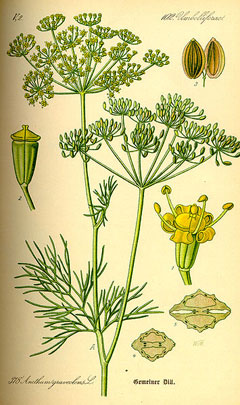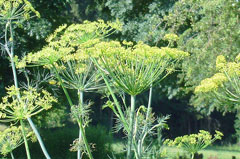 |
|
http://commons.wikimedia.org/wiki/File:Illustration_Anethum_graveolens0.jpg |
 |
| http://commons.wikimedia.org/wiki/User:Maksim |
Translate this page:
Summary
Bloom Color: Yellow.
Main Bloom Time: Early summer, Late summer, Mid summer. Form: Upright or erect.
Physical Characteristics

 Anethum_graveolens is a ANNUAL growing to 0.8 m (2ft 7in) by 0.2 m (0ft 8in) at a medium rate.
Anethum_graveolens is a ANNUAL growing to 0.8 m (2ft 7in) by 0.2 m (0ft 8in) at a medium rate.
See above for USDA hardiness. It is hardy to UK zone 8. It is in leaf from May to November, in flower from April to July, and the seeds ripen from July to August. The species is hermaphrodite (has both male and female organs) and is pollinated by Bees. The plant is self-fertile.
It is noted for attracting wildlife.
Suitable for: light (sandy) and medium (loamy) soils and prefers well-drained soil. Suitable pH: mildly acid, neutral and basic (mildly alkaline) soils. It cannot grow in the shade. It prefers moist soil.
UK Hardiness Map
US Hardiness Map
Synonyms
Peucedanum graveolens.
Plant Habitats
Edible Uses
Leaves - raw or cooked[2, 4, 9, 14, 21]. Used as a flavouring in salads etc[132, 183]. The leaves lose their flavour if the are cooked for any length of time and so are best used raw or added to cooked dishes only a few minutes before the cooking is complete[244]. The leaves can be harvested at any time the plant is growing, but are best just before the plant flowers[244]. Per 100g, the plant contains 253 calories, 7.2g water, 20g protein, 4.4g fat, 55.8g carbohydrate, 11.9g fibre, 12.6g ash, 1784mg calcium, 543mg phosphorus, 48.8mg iron, 451mg magnesium, 208mg sodium, 3,308mg potassium, 3.3mg zinc, 0.42mg thiamine, 0.28mg riboflavin, 2.8mg niacin and 1.5mg vitamin B6[218]. Seed - raw or cooked. Very pungent and bitter in taste[4]. It is used as a flavouring in salads, preserves etc[2, 7, 9, 21, 46, 183], its chief uses being perhaps in making dill vinegar and as a flavouring in pickled gherkins[4]. It can also be sprouted and used in breads, soups and salad dressings[183]. Per 100g, the seed contains 305 calories, 7.7g water, 14.5g fat (0.73g saturated, 124mg phytosterol and no cholesterol), 55.2g carbohydrate, 21g fibre, 6.7g ash, 1,516mg calcium, 277mg phosphorus, 16.3mg iron, 256mg magnesium, 20mg sodium, 1,186mg potassium, 5.2mg zinc, 53IU vitamin A, 0.42mg thiamine and 0.28mg riboflavin[218]. An essential oil from the seed is used as a flavouring in the food industry[46, 105]. A tea is made from the leaves and/or the seeds[183].
References More on Edible Uses
| Composition
|
| Figures in grams (g) or miligrams (mg) per 100g of food.
|
|
|
Leaves (Fresh weight)
|
|
- 253 Calories per 100g
- Water : 7.2%
- Protein: 20g; Fat: 4.4g; Carbohydrate: 55.8g; Fibre: 11.9g; Ash: 12.6g;
- Minerals - Calcium: 1784mg; Phosphorus: 543mg; Iron: 48.8mg; Magnesium: 451mg; Sodium: 208mg; Potassium: 3308mg; Zinc: 3.3mg;
- Vitamins - A: 0mg; Thiamine (B1): 0.42mg; Riboflavin (B2): 0.28mg; Niacin: 2.8mg; B6: 1.5mg; C: 0mg;
- Reference: [ ]
- Notes:
|
|
Medicinal Uses
Plants For A Future can not take any responsibility for any adverse effects from the use of plants. Always seek advice from a professional before using a plant medicinally.
Dill has a very long history of herbal use going back more than 2,000 years. The seeds are a common and very effective household remedy for a wide range of digestive problems. An infusion is especially efficacious in treating gripe in babies and flatulence in young children. The seed is aromatic, carminative, mildly diuretic, galactogogue, stimulant and stomachic[4, 21, 46, 165]. It is also used in the form of an extracted essential oil[243]. Used either in an infusion, or by eating the seed whole, the essential oil in the seed relieves intestinal spasms and griping, helping to settle colic[254]. Chewing the seed improves bad breath[254]. Dill is also a useful addition to cough, cold and flu remedies, it can be used with antispasmodics such as Viburnum opulus to relieve period pains[254]. Dill will also help to increase the flow of milk in nursing mothers and will then be taken by the baby in the milk to help prevent colic[254].
References More on Medicinal Uses
The Bookshop: Edible Plant Books
Our Latest books on Perennial Plants For Food Forests and Permaculture Gardens in paperback or digital formats.

Edible Tropical Plants
Food Forest Plants for Hotter Conditions: 250+ Plants For Tropical Food Forests & Permaculture Gardens.
More

Edible Temperate Plants
Plants for Your Food Forest: 500 Plants for Temperate Food Forests & Permaculture Gardens.
More

More Books
PFAF have eight books available in paperback and digital formats. Browse the shop for more information.
Shop Now
Other Uses
The seed contains up to 4% essential oils[244]. It is used in perfuming soaps[4], medicines and as a food flavouring[244]. Some compounds of dill (d-carvone is mentioned as one of them), when added to insecticides, have greatly increased the effectiveness of the insecticides[218].
Special Uses
References More on Other Uses
Cultivation details
Landscape Uses:Border, Container. An easily grown plant[4], it prefers a moderately rich loose soil and full sun[14, 27, 88]. Requires a well-drained soil[27] and shelter from the wind[200]. Tolerates a pH in the range 5.3 to 7.8. Dill is a commonly cultivated herb, especially in warm temperate and tropical zones. It is grown mainly for its edible leaves and seeds, though it is also used medicinally. There are many named varieties[142, 183]. 'Bouquet' is an American cultivar that has a prolific production of seeds[238]. The sub-species A. graveolens sowa from India has a slightly different flavour to the type species[238]. The plant quickly runs to seed in dry weather[200]. It often self-sows when growing in a suitable position[37, 88]. A good companion for corn and cabbages, also in moderation for cucumbers, lettuce and onions, but it inhibits the growth of carrots[14, 18, 20]. Dill reduces a carrot crop if it is grown to maturity near them[201]. However, the young plant will help to deter carrot root fly[201]. The flowers are very attractive to bees[14, 18, 20]. Special Features:Attractive foliage, Edible, Fragrant foliage, Not North American native, Naturalizing, Attracts butterflies, Suitable for cut flowers, Suitable for dried flowers.
References Carbon Farming Information and Carbon Sequestration Information
Temperature Converter
Type a value in the Celsius field to convert the value to Fahrenheit:
Fahrenheit:
The PFAF Bookshop
Plants For A Future have a number of books available in paperback and digital form. Book titles include Edible Plants, Edible Perennials, Edible Trees,Edible Shrubs, Woodland Gardening, and Temperate Food Forest Plants. Our new book is Food Forest Plants For Hotter Conditions (Tropical and Sub-Tropical).
Shop Now
Plant Propagation
Seed - sow April to early summer in situ and only just cover[200, 238]. The seed germinates in 2 weeks if the soil is warm. A regular supply of leaves can be obtained if successional sowings are made from May to the end of June[89, 200]. Autumn sowings can succeed if the winters are mild[4]. Dill is very intolerant of root disturbance and should not be transplanted because it will then quickly run to seed.
Other Names
If available other names are mentioned here
Native Range
Algeria, Chad, Cyprus, Gulf States, Iran, Lebanon-Syria, Libya, Morocco, Oman, Saudi Arabia, and Tunisia.
Weed Potential
Right plant wrong place. We are currently updating this section.
Please note that a plant may be invasive in one area but may not in your area so it's worth checking.
Conservation Status
IUCN Red List of Threatened Plants Status :

Growth: S = slow M = medium F = fast. Soil: L = light (sandy) M = medium H = heavy (clay). pH: A = acid N = neutral B = basic (alkaline). Shade: F = full shade S = semi-shade N = no shade. Moisture: D = dry M = Moist We = wet Wa = water.
Now available:
Food Forest Plants for Mediterranean Conditions
350+ Perennial Plants For Mediterranean and Drier Food Forests and Permaculture Gardens.
[Paperback and eBook]
This is the third in Plants For A Future's series of plant guides for food forests tailored to
specific climate zones. Following volumes on temperate and tropical ecosystems, this book focuses
on species suited to Mediterranean conditions—regions with hot, dry summers and cool, wet winters,
often facing the added challenge of climate change.
Read More
Expert comment
Author
L.
Botanical References
100200
Links / References
For a list of references used on this page please go here
Readers comment
| Add a comment |
|
If you have important information about this plant that may help other users please add a comment or link below. Only comments or links that are felt to be directly relevant to a plant will be included. If you think a comment/link or information contained on this page is inaccurate or misleading we would welcome your feedback at [email protected]. If you have questions about a plant please use the Forum on this website as we do not have the resources to answer questions ourselves.
* Please note: the comments by website users are not necessarily those held by PFAF and may give misleading or inaccurate information.
To leave a comment please Register or login here All comments need to be approved so will not appear immediately.
|
Subject : Anethum_graveolens
|
|
|
|